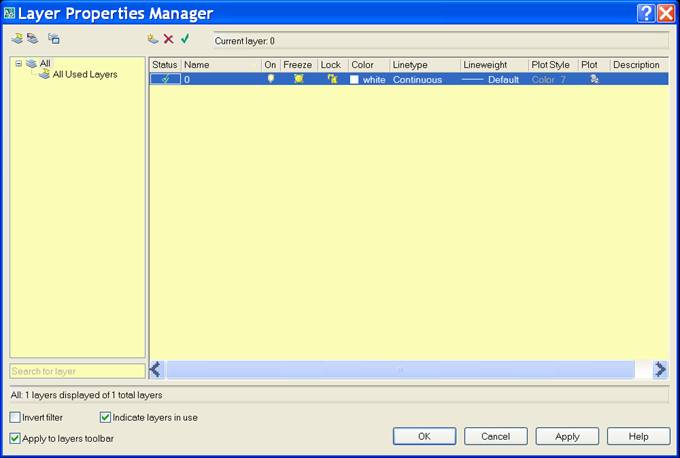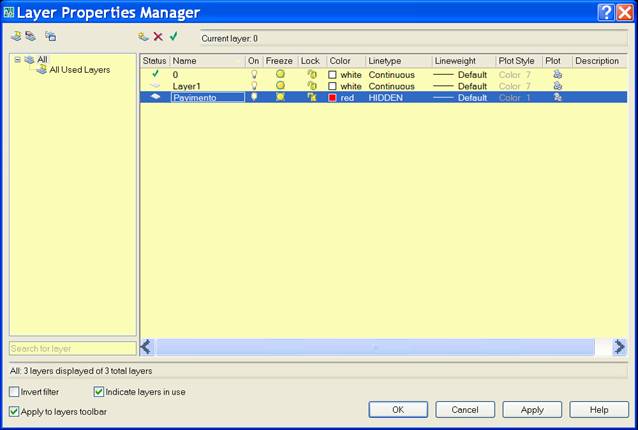“Layers"
On Autocad, Layers are like levels or sheets, of which we can assign certain parts of a drawing.
Through the appropriate command window we can create at will and can set a name, a base color, and a kind of linetype.
The base Linetype and color however it isn't binding, in fact within the same layer you can draw with any color or line available, using the function seen previously.
Through the appropriate command window we can create at will and can set a name, a base color, and a kind of linetype.
The base Linetype and color however it isn't binding, in fact within the same layer you can draw with any color or line available, using the function seen previously.
Let's see the "layers toolbar":

Clicking the first button on the left of the toolbar:

On the "Layer Manager", we see at present, only the layer "0".
Above are the three keys that match:
that match:
:
-New-layer (to create new layer)
-Delete layer [ note: you can not delete layers that are not empty]
-Set current (set as the current layer)
Above are the three keys
:
-New-layer (to create new layer)
-Delete layer [ note: you can not delete layers that are not empty]
-Set current (set as the current layer)
These same voices in the menu that appears when we right-click inside the window layer (in the biggest right).
We can create multiple layers, but always drawn on one at a time, the current layer.
If we click "new layer" will create a new layer called "Layer1" which will appear in the window. Right now if necessary, we can just rename it at will.
The following image I created two new layers, the first, layer1 I left as the default, the second I renamed as the "floor" (in italian "Pavimento") I assigned the color red and I changed the line type in HIDDEN, as base settings.
The following image I created two new layers, the first, layer1 I left as the default, the second I renamed as the "floor" (in italian "Pavimento") I assigned the color red and I changed the line type in HIDDEN, as base settings.
To rename a layer, we have selected in the layer manager and press the "F2" key on your keyboard.
The layer name will edit it and we can rename it at will.
The layer name will edit it and we can rename it at will.

Pressing "Apply" and "OK" to confirm this setting and close the window layer.
The current layer is still "0", it is what we see written in the window of the "layer toolbar"

This means that the lines we draw will be part of this layer.
Clicking on the window of the "layers toolbar" opens a drop down list where we see the layers in the drawing, then 0, layer1 and floor (Pavimento).

Selecting one of the layers present, such as "floor" (Pavimento), set it as current layer, from then on the lines or objects that we are going to draw belong to this layer and hence will have the characteristics we have set, red color and line type HIDDEN.
This at least, if we leave the setting "BYLAYER" for the color and type of line on the "properties toolbar", if we assign a different color or line type, different from those set for the layer, these will take precedence and will be used to draw.
Displayed the lines depend on the hidden variable LTSCALE.
Attention now: Doing the same operation, by selecting a layer in the down special, but after selecting one or more objects in the drawing, we will change the layer are member of these objects, but in this case, when press Esc to deselect it, we see that the layer current remains 0.
Then we assigned the layer "floor"(Pavimento) to selected objects, but we continue to draw in the layer 0.
Then we assigned the layer "floor"(Pavimento) to selected objects, but we continue to draw in the layer 0.
In summary, we can create different layers and give it different names, colors and type of lines.
We can set object colors to your liking or leave it as setting on the layer manager "BYLAYER".
We can assign to different line type, or leave it as setting on the layer manager "BYLAYER".
We can set object colors to your liking or leave it as setting on the layer manager "BYLAYER".
We can assign to different line type, or leave it as setting on the layer manager "BYLAYER".
As you may have noticed, both on the layer drop-down menu and in the layer-manager window, there are other symbols for each layer: a light bulb, a kind of sun, and a padlock.
Are the controls, ON / OFF, FREEZE, LOCK.
Both from the drop-down list of layers and from the layer-manager window, can act on these functions.

Are the controls, ON / OFF, FREEZE, LOCK.
Both from the drop-down list of layers and from the layer-manager window, can act on these functions.

The first ON / OFF, allows you to set visible or not, the various layers present , then if you open the drop-down menu and you click the "bulb" of layer "floor" you set it off, so objects that are part of the design of this layer will disappear.
Repeating the operation reactivate the layer, the design reappears on the screen.
Repeating the operation reactivate the layer, the design reappears on the screen.
The FREEZE function is equivalent to say that first described, at least as regards this course.
You have to keep in mind that a layer set to "off" can remain as the current layer, then we can draw with it.
If we draw a line using a layer off, will not appear on the screen, since the layer is disabled, but will be drawn and we will turn visible, resetting the layer ON.
Unlike a layer off with the FREEZE function can not be used as the current layer, thus preventing you can continue drawing in it.
You have to keep in mind that a layer set to "off" can remain as the current layer, then we can draw with it.
If we draw a line using a layer off, will not appear on the screen, since the layer is disabled, but will be drawn and we will turn visible, resetting the layer ON.
Unlike a layer off with the FREEZE function can not be used as the current layer, thus preventing you can continue drawing in it.
The LOCK function instead, when enabled will lock the layer concerned, which remain visible on the screen, but should prevent edit or delete the parts that are already drawn on this layer.
Also in this case, It will be maintain the current layer "locked", and continue to draw objects inside which, however, once created it will be immediately blocked and no longer editable until they turn off the lock.
In practice the layer is used to subdividing drawings to some parts, such as plant design of a room can be divided into several layers of walls, floors, furniture, false ceiling etc.. turning off or locking, if necessary, the layer on which we must not work or that we should not see.
Although you can create a vast amount of layers. ... And many do, (you will realize if you happen to work on drawings made by others), you should not overdo it and kept to the minimum necessary to maintain order as much as possible in the design and not to lose control of what we're doing.
It will be very easy indeed if not, end up with parts of the design scattered to many layers where they should not be, and have to wasting time to fix it up.
You will see that this happens even working with only two layers, if you are not careful.
A good technical drawing could be featured in a single layer, merely using different colors for different objects like walls, floors, furnishings, etc.
It will be very easy indeed if not, end up with parts of the design scattered to many layers where they should not be, and have to wasting time to fix it up.
You will see that this happens even working with only two layers, if you are not careful.
A good technical drawing could be featured in a single layer, merely using different colors for different objects like walls, floors, furnishings, etc.

0 comments:
Post a Comment